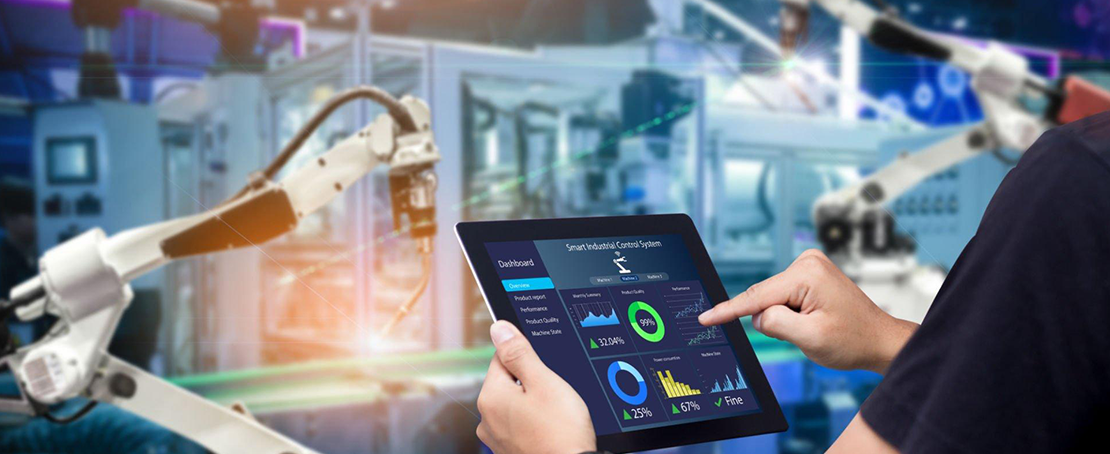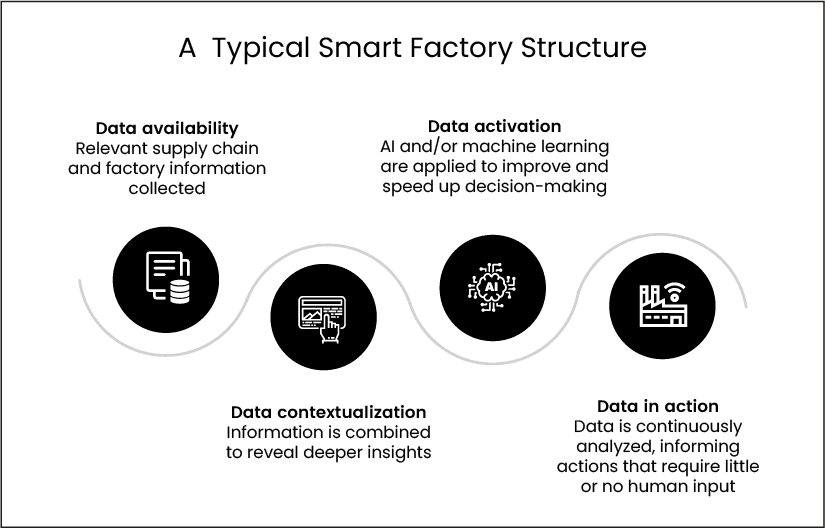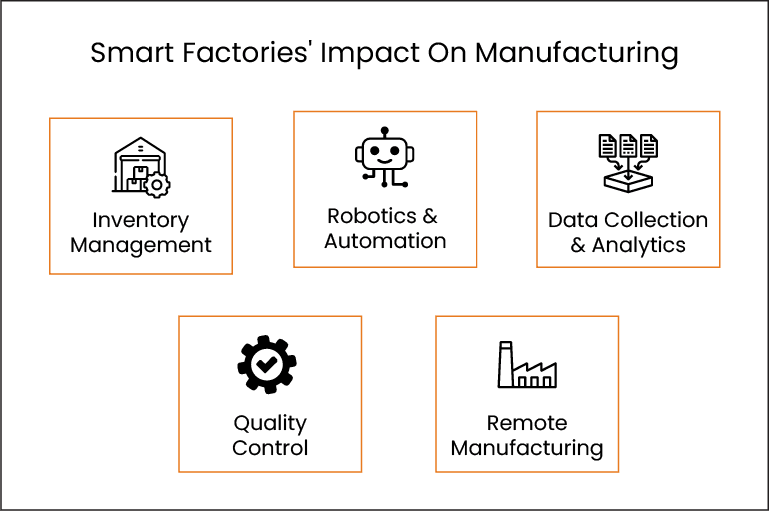- November 28, 2023
- Posted by: Uma Raj
- Category: Industries

Nowadays, manufacturers face growing challenges in minimizing expenses, expediting production, and promptly responding to market demands. To address sustainability issues, manufacturers are actively exploring innovative technologies and approaches. Smart factories are crucial in the fourth industrial revolution, making factories more connected, collaborative, and data-focused.
What’s a smart factory?
A smart factory represents a modernized manufacturing facility that employs digital manufacturing techniques, equipment, and systems to gather and exchange data continuously. This data is the foundation for making informed choices to enhance operations and tackle manufacturing issues. The smart factory embodies an innovative phase in the industrial revolution, emphasizing the utilization of real-time data, connectivity, automation, and machine learning. It seamlessly integrates the digital and physical worlds to oversee the complete production cycle, from supply chain management to the operation of manufacturing equipment.

Consult with Indium’s smart factory experts to unlock the full potential of your manufacturing processes. Check out our automation, data analytics, and cutting-edge technology for improved productivity.
Inquire Now
Why should you embrace smart factories?
According to the Marketsandmarkets report, the smart manufacturing market is expected to grow to USD 241.0 billion by 2028. Across various industries and sectors, most enterprises view smart factories as immensely advantageous and indispensable. Here are a few advantages:
Measure KPIs: Smart factories offer managers precise and automated data, empowering them to assess key performance indicators efficiently.
Anticipate future events and plan: Smart predictive maintenance in smart factories enables managers to forecast and address maintenance issues more efficiently and rapidly.
Optimized demand handling: Through more precise forecasting, it minimizes waste, facilitating efficient demand management.
Enhanced productivity: Managers can improve productivity by accessing seamless data regarding machine maintenance and identifying potential bottlenecks.
Smart factories—real-life use cases
John Deere’s 5G network and digital twin innovations: Revolutionizing manufacturing in the Midwest
John Deere, a farm equipment manufacturer, established its private 5G network by acquiring 50 MHz bandwidth rights. This network is specifically designed to enhance operations in its Midwestern factories, facilitating the analysis of production line data for assembly process improvement. John Deere has plans to introduce collaborative robots working alongside human employees within these facilities. Furthermore, the company is creating 3D models, often called digital twins, for its production machinery. These models serve multiple purposes: performance monitoring, technician training, and equipment servicing. They are conveniently accessible on tablets and smartphones, ensuring always easy availability.
Ford’s 5G-enabled production and AI-powered welding: Transforming electric vehicle manufacturing
In Ford’s Dearborn, Michigan factory, which manufactures the electric F-150 lightning pickup truck, workers on the production line use tablets connected to the factory’s 5G network. This connectivity enables them to access critical material supplies and equipment status data. Meanwhile, in Ford’s electric vehicle factory in the UK, sensors play a pivotal role in capturing images of the welding process. It is of utmost importance in producing electric vehicle motors and batteries, as it involves thousands of welds. Subsequently, artificial intelligence (AI) systems determine the quality of these welds. If a weld fails to meet the specified standards, it is rectified before the part proceeds to the subsequent production stage. This innovative approach saves time and minimizes waste by recovering parts that might otherwise be unusable.
Manufacturing landscape transformation and its potential impact on our work processes
A smart factory harnesses the capabilities of sophisticated data analytics and artificial intelligence, allowing it to fine-tune production parameters for optimal efficiency and profitability dynamically. It maintains seamless connectivity with suppliers, partners, customers, and its workforce through a unified communication system. Furthermore, the smart factory is equipped with sensors and software that systematically gathers data about its operational environment and internal processes. This data is then leveraged to identify issues and initiate corrective measures as necessary.
Smart factories are particularly well-suited for enterprises leveraging robotics and other advanced technologies to create their products. Such companies require seamless and reliable communication channels connecting their robotic systems with central command centers. These advancements are poised to enhance manufacturing organizations’ efficiency and profitability significantly. The transition to smarter and more productive factories will be driven by improved data utilization and artificial intelligence integration. As manufacturing evolves into a data-centric and intelligent industry, manufacturers will be better prepared to stay competitive.
“Each customer’s decision while designing their product leads to modifications in our manufacturing workflow. Addressing this within the process layout becomes highly sophisticated to manage. We recognized that overcoming this complex logistics challenge requires implementing autonomous mobile robots.”
Kurt Oberparleiter, Vice President—Operations, Sunview Patio Doors
Smart factories are reshaping the manufacturing landscape in five key areas

1. Inventory management
Effective inventory management is critical for manufacturers, as it requires locating materials, determining their quantities, and monitoring their consumption. By integrating a comprehensive tracking system, businesses gain insights into the precise whereabouts, quantities, and conditions of materials throughout various production stages. This level of visibility empowers companies to optimize their inventory management by anticipating demand, reducing instances of stockouts, and mitigating overproduction, all of which contribute to improved customer satisfaction. This tracking system can encompass tools like barcode scanners, RFID tags, or other inventory management software to strengthen supply chain and warehouse operations. In smart factories, sensors are pivotal in continuously monitoring and analyzing inventory levels and product consumption. For instance, sensors fixed to conveyor belts can efficiently track products. This approach offers several advantages, most notably eliminating manual data entry and monitoring by workers while ensuring real-time inventory tracking.
2. Robotics
The integration of robots in manufacturing is on the rise, propelled by the continuous development of advanced technologies and the declining costs associated with robotics. Progress in fields like vision systems, artificial intelligence, and others will further enhance the role of robots within smart factories. When manufacturing companies are engaged in products suitable for automation, they can leverage robots and automated machinery to streamline their production processes. These robots can be programmed to execute tasks more efficiently and reliably than their human counterparts without requiring rest periods. Automation systems enable manufacturers to boost their production output with fewer human resources and within reduced spatial requirements, consequently decreasing operational expenses and boosting profitability.
Various technologies, including sensors, cameras, and other monitoring tools, are employed within a smart factory environment to assess and analyze the performance of robots and automated equipment. This proactive approach enables identifying and preventing issues before they occur, allowing manufacturers to address equipment concerns remotely.
3. Data analysis
Data gathered by sensors within a smart factory can be transmitted to a centralized data platform, where it is stored, analyzed, and visualized. This data catalyzes productivity, efficiency, and customer satisfaction, as it aids in monitoring product defects and the status of shipments. Automated data collection and analytical dashboards enable manufacturers to identify operational inefficiencies, including machinery breakdowns and production bottlenecks. For instance, a manufacturing facility can analyze the time required for material reception and producing and delivering finished goods. The factory can identify the root causes of bottlenecks in the production process through data analysis and initiate corrective measures.
4. Quality control
Ensuring product quality is pivotal for enhancing customer satisfaction. Within manufacturing operations, the application of sensors for real-time production monitoring, material tracking, and on-the-fly product testing is an effective strategy to mitigate the risk of defects. To illustrate, sensors can be fixed to machinery to identify abnormal readings promptly and prevent potential defects. Automated quality assessments are executed through sensors, cameras, and other technologies to collect data, identify issues, and initiate corrective measures.
The data analysis derived from this process reveals discernible patterns in product quality. Manufacturers can leverage this information to instigate necessary alterations in their production processes. Automated quality control systems offer the advantage of inspecting a higher volume of products per hour than manual inspections, ultimately translating into elevated product quality and increased customer satisfaction.
5. Remote manufacturing
Effective communication and collaboration among employees and various departments are pivotal factors for a company’s success. Adopting collaboration tools and software, such as team communication applications, video conferencing platforms, and team task management systems, empower companies to enhance communication and nurture collaborative efforts. In today’s technologically advanced manufacturing settings, workers wield the power of their smartphones to engage with the production process and access real-time data. They can traverse the production line using tablets to visually inspect products and input data. Furthermore, integrating robots allows workers to remotely supervise and address issues with the production floor through their mobile devices. This remote troubleshooting capability saves employees time and financial resources, as they are not required to physically visit the equipment on-site to resolve problems.
Final words
The future of the manufacturing industry is exceptionally promising. Advancements in technology have steered the era of smart factories, where manufacturers operate within a networked, data-centric, and highly automated ecosystem. These forward-looking enterprises employ a combination of sensors, robotic systems, and collaborative software to gather data, inspect operations, and enhance productivity and efficiency.
Smart factories are replacing conventional, static manufacturing facilities, evolving into digital entities capable of tracking, managing, and optimizing industrial assets. Through continuous monitoring of automated resources, optimized resource allocation, and automation applications, manufacturers can significantly enhance production efficiency and expedite introducing new products to the market. Smart factories benefit the environment and the workforce and increase productivity, cost reduction, and customer satisfaction.
Manufacturers now have a wealth of data at their disposal, with the ability to conduct real-time data analysis and detect trends. To fully harness the potential of this data-rich landscape, manufacturers must develop tailored applications and systems for data utilization and analysis, effectively leveraging the advantages of smart manufacturing. Maximizing the potential of smart manufacturing practices can increase profits and optimize operational performance for companies.
Partner with Indium for smart factory success and drive innovation in your manufacturing journey. With our guidance and solutions, you can achieve higher efficiency, reduced costs, and enhanced customer satisfaction




